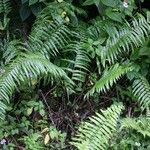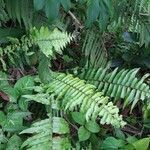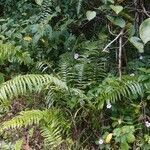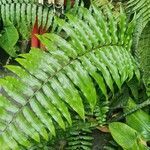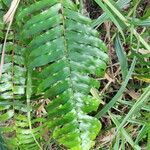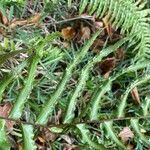Habit, rhizome morphology. Plants forming tufts of 3-5 fronds. Runners 1-2.5 mm thick, branching angle divaricate. Scales on runners very sparse to dense, spreading or squarrose. Tubers absent. Fronds 120-160 by 19-25 cm, stipe 29-42 cm long. Lamina base truncate, tapering over 40-50 cm, basal pinnae 3.5-4 cm long, 4.5-5 cm distant, middle pinnae straight or slightly falcate (or somewhat recurved). Sterile pinnae 8-11 by 1.5-2 cm, herbaceous, thick or leathery, base equal or slightly unequal, basiscopic base cuneate, truncate or rounded, acroscopic base cuneate or truncate, slightly to distinctly auricled, margin in basal part crenate, towards apex serrate or dentate, apex obtuse, acute or acuminate. Fertile pinnae 9-15 by 0.9-1.3 cm, more strongly serrate than the sterile pinnae. Indument. Basal scales pseudopeltate, spreading (often somewhat falcately curved), 5 by 0.8 mm, central part light brown, shining, hyaline margin present in lower part only, marginal glands present around the base, small, margin in basal part fimbriate, acumen dentate, apex entire. Rhachis scales sparse or dense, spreading, hyaline or light brown, with a well-developed protracted entire acumen. Scales on lamina usually persistent. Hairs on lamina absent or sometimes present, costa sometimes present. Sori submarginal or medial, 50 pairs on fully fertile pinnae, round, not impressed. Indusium reniform, with narrow sinus, attached at sinus.
Stem scales loosely appressed to spreading, concolored or bicolored with pale margins. Tubers absent. Leaves 2--22 × 0.3--3.5 dm. Petiole 0.2--5.4 dm, sparsely to moderately scaly; scales spreading, reddish to light brown throughout (rarely with pale margins). Blade sparsely to densely scaly, glabrous or pubescent, hairs mostly on veins and abaxial, pale to light brown, 0.2--0.7 mm. Rachis 1.8--17 dm, points of pinna attachment 7.5--35 mm apart; scales moderately spaced, pale brown throughout. Central pinnae narrowly deltate to narrowly elliptic-lanceolate, 2.5--23 × 0.5--2 cm, base cuneate, truncate to auriculate-cordate acroscopically, rounded basiscopically, acroscopic lobe small and oblong or absent, margins biserrate to serrulate, apex attenuate; costae adaxially glabrous or densely hairy, hairs erect, pale, 0.3 mm. Indusia circular to horseshoe-shaped, peltate or attached at narrow sinus, 0.8--1.1 mm wide. 2 n = 82.
Rhizome erect. Fronds suberect to arching; stipe pale brown, up to 220 mm long, set with pale brown, narrowly lanceolate scales up to 2 mm long, becoming subglabrous with age; lamina narrowly elliptic, c. 600 x 240 mm, acute, pinnate, lower pinnae only slightly reduced; pinnae shortly petiolate, up to 36 pairs, very narrowly oblong, attenuate, crenate, base broadly cuneate, thinly pilose with minute white hairs when young, becoming subglabrous, submarginal hydathodes present but not conspicuous; rhachis pale brown, thinly pilose and set with scattered scales. Sori c. 4 mm apart in a line 2/3 the distance from costa to margin, c. 1 mm in diameter, opening outwards at right angles to veins; indusium membranous, entire, c. 0.6 mm in diameter.
Stolons and basal portions of stipes scaly; scales lanceolate, red-brown, with few to many short or long marginal cilia. Fronds to 2.5 m or more long; rachis with scattered hair-like scales and/or simple hairs, glabrescent. Pinnae relatively widely-spaced, sometimes with a small rounded auricle. Sterile pinnae 25–120 mm long, 8–30 mm wide, usually glabrous, occasionally with ciliate scales; base often obliquely truncate; margins shallowly crenate; midrib sometimes with simple hairs. Fertile pinnae 100–240 mm long, 10–30 mm wide; margins more deeply crenate. Sori between half and two-thirds distance from midrib to margin; indusium reniform.
Rhizome with rufous, lanceolate scales. Stipe grayish brown, 10-50 cm × ca. 4 mm, covered with lanceolate and fibrillar scales at base; lamina brownish green when dry, narrowly elliptic, 0.7-2 m or longer, 14-30 cm wide, papery, with sparse, lanceolate or linear scales when young, glabrous on both surfaces when mature; pinnae 30-55 pairs, 1.5-3 cm apart, subsessile, margin minutely serrulate, teeth remote, apex acute or acuminate, basal pairs of pinnae gradually shorter. Sori submedial, 1-2 mm apart, orbicular, 1.5-2 mm in diam.; indusia brown, orbicular-reniform, glabrous, sinus narrow.
A tufted fern with slender runners. The rhizomes have scales. The fronds can be up to 2.5 m long, erect and bright green. They are divided once. It is a coarse woody fern that grows in tangled colonies. These small plants grow from the branched wiry runners. The spore bearing bodies are round and lie in a row between the midrib and leaf edge.
Frond-bearing rhizome erect. Plant up to 1 m high. Fronds pinnate to 2-pinnatifid. Stipes not articulated.Lamina narrowly elliptic, ± 600 x 240 mm. Sori opening towards pinna margin, ± 4 mm apart, in a line along margin.
Terrestrial or epiphytic
